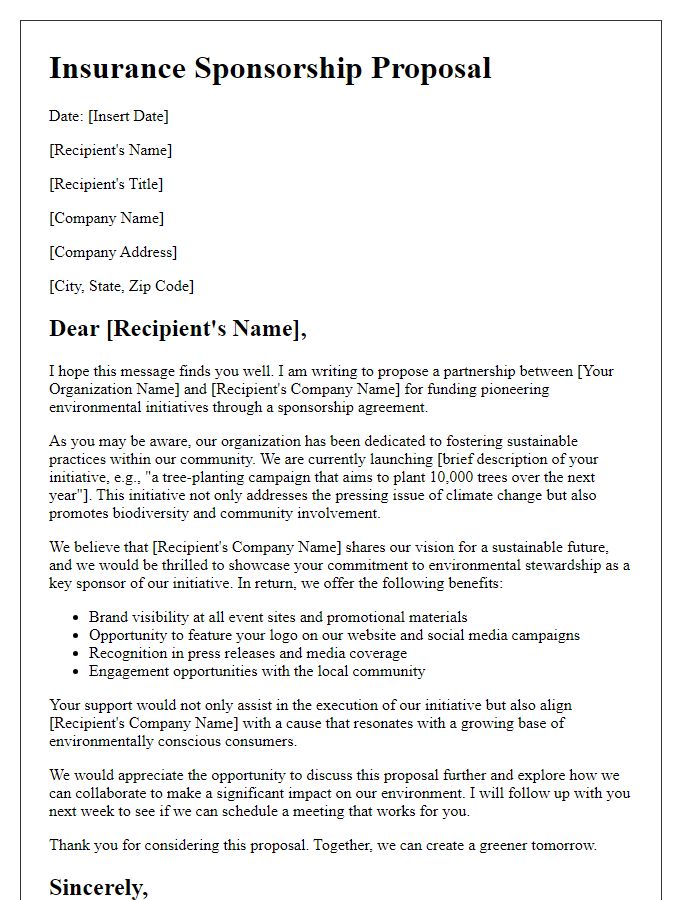Are you looking to secure sponsorship for your upcoming event, and need a compelling letter to captivate potential insurance partners? Crafting the right proposal is essential, as it sets the tone for your collaboration and showcases the mutual benefits of partnership. In this article, we'll guide you through creating an effective letter template that highlights your event's value and aligns with the sponsor's goals. Dive in to discover the secrets to a persuasive insurance sponsorship proposal!

Clear and Concise Proposal Objective
Insurance sponsorship proposals often seek financial or resource support to enhance programs or events. A clear and concise objective might outline the specific goals, such as increasing community engagement or providing educational workshops. For instance, a proposal could aim to secure $10,000 funding for a series of health and safety workshops focused on preventing accidents, targeting local businesses and schools. The proposal should emphasize mutual benefits, such as increased visibility for the insurance company and strengthened community relations, attracting a wider audience while promoting safety awareness. Emphasizing measurable outcomes, like participation rates or feedback scores, provides a solid foundation for the sponsorship request.
Detailed Sponsorship Benefits
A well-structured insurance sponsorship proposal should highlight the tangible benefits for both parties involved, particularly focusing on brand visibility, community engagement, and potential revenue generation. By sponsoring events or activities, insurance companies can enhance their brand recognition among target demographics, such as local businesses or community members. Sponsored events, like health fairs or safety seminars (typically attended by hundreds of participants), provide opportunities for direct engagement, allowing representatives to connect with potential policyholders. Additionally, sponsoring community initiatives--like youth sports teams--can foster loyalty and goodwill, emphasizing the company's commitment to social responsibility. Digital and print marketing materials, featuring the sponsor's logo, in various media, can amplify their reach further, leading to increased inquiries and potential sales.
Target Audience and Demographics
The target audience for the insurance sponsorship proposal encompasses young professionals aged 25 to 35, residing in urban areas with a population density exceeding 500,000. This demographic increasingly seeks financial security, with 70% showing interest in comprehensive insurance coverage, including health, auto, and life insurance. Within this group, a majority (approximately 60%) are tech-savvy individuals who prefer digital engagement through apps and social media platforms. Furthermore, the proposal aims to reach families planning for the future, particularly those with children under 12, representing a market segment that values stability and security, accounting for roughly 40% of the audience. Understanding their preferences is crucial for tailoring sponsorship initiatives that resonate effectively and foster long-term relationships.
Strategic Brand Alignment
Strategic brand alignment involves creating a cohesive partnership between organizations that enhances brand value and visibility for both parties. In the realm of insurance, companies like Aetna and State Farm actively seek sponsorship opportunities that resonate with their brand values and target demographics. Sponsorship of community events, such as the New York City Marathon or local charity initiatives, positions insurance brands prominently in high-traffic environments, reaching potential customers effectively. These sponsorships often result in brand recognition growth, fostering trust through community engagement. Companies also leverage social media campaigns linked to these events, amplifying their reach and connecting with audiences through shared values and experiences, contributing to enhanced brand loyalty.
Call-to-Action and Follow-up Steps
A well-crafted insurance sponsorship proposal highlights the mutual benefits of collaboration, outlining targeted audience engagement and measurable outcomes. Potential sponsors, such as national insurance companies or local firms, should consider the impact of their support on community initiatives or events, such as charity drives or health fairs. Clear call-to-action directives must be included, encouraging sponsors to commit by specific dates and outlining expected contributions or sponsorship levels. Follow-up steps should focus on scheduling meetings within the next two weeks, providing additional information, or arranging presentations, ensuring transparent communication regarding expectations, deliverables, and promotional opportunities associated with the sponsorship. Detailed timelines, including sponsor acknowledgment during events or in marketing materials, enhance the attractiveness of the proposal, fostering a collaborative relationship.
Letter Template For Insurance Sponsorship Proposal Samples
Letter template of insurance sponsorship proposal for charitable organizations.

Letter template of insurance sponsorship proposal for health and wellness initiatives.

Letter template of insurance sponsorship proposal for environmental initiatives.














Comments